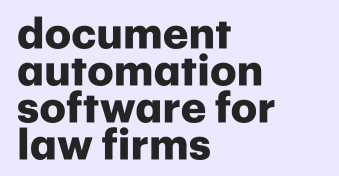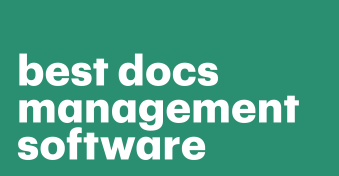Document automation can be a major time saver when creating business documents.
This is done by allowing users to change the necessary details of the document while keeping the bulk of the content the same.
So, what does that process look like?
The most rudimentary example of an automated document is a generic form letter.
All you need to do is change the addressee and send it to the appropriate recipient.
But modern document automation is far more complex than that.
Today, everything from invoices to contracts and proposals can be automated using variables, conditional logic, integrations, and workflow automation.
Below, we’ve selected nine of the best document automation software options out there today.
If you’re in the market for a way to streamline your document workflow, be sure to give them a try!
Key takeaways
- Document automation relies on using tools to automatically input details from a data source into a document template.
- In most cases, data sources must be manually mapped to the given variables and templates must be created manually.
- Some software options are focused strictly on automation. Others combine automation with other features, like document generation or brand compliance.
1. PandaDoc
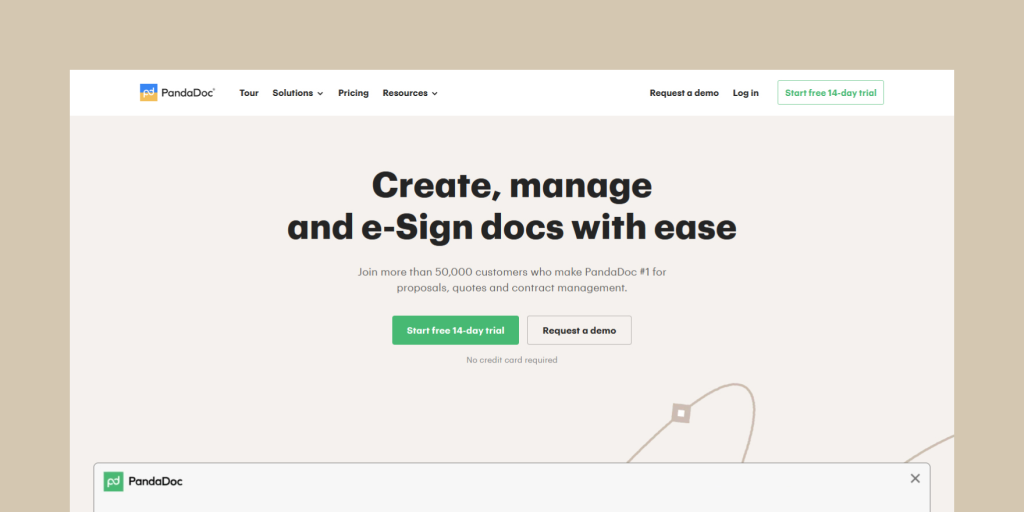
Our rating: 4.8/5
Pricing: Free eSign ($0); Essentials ($19 user/month); Business ($49 user/month); Enterprise pricing available.
Who is this tool for? Businesses and teams looking to automate and scale their document workflow.
Best automation feature: Custom content library.
When it comes to document automation, PandaDoc has packed almost every tool you need into a friendly user interface that connects to software tools in your tech stack.
The entire platform was built around the idea that creating and managing business documents should be fast, simple, and efficient.
With that in mind, the PandaDoc platform is equipped with an arsenal of tools designed to streamline and automate your document workflow.
Take a look for yourself:
Content library
Save entire documents or individual content blocks in your library to reuse them later.
Perfect for teams who need to insert specialized or personalized content to existing templates on an as-needed basis.
Built-in document editor
Create documents entirely from scratch within our onboard, cloud-based editor.
Work from anywhere, and invite other team members (and clients!) to collaborate and/or sign documents.
Onboard template library
Jumpstart your process with 1000+ document templates from our library.
Use them to create new documents, or modify them with additional functionality and branding to create unique templates for your organization.
API and native integrations
Want to bring the power of PandaDoc to Google Docs or Microsoft Word?
Need to connect your Salesforce and HubSpot customer data directly to your document variables?
Integrate! PandaDoc has native integrations for most major CRMs and word processing apps.
We also connect to Zapier and offer an open API (REST) so that you can integrate PandaDoc into your own apps and services.
Smart content assembly
Build workflows around your content so that it practically writes itself!
Combine content blocks with conditional logic (just like you would when building a form) to create documents that automatically generate personalized content as users interact with them.
Custom user roles
Keep your content consistent and on-brand by creating user roles that restrict modification on pre-approved templates.
This allows users to generate documents from allowed templates and customize them in minor ways, but it ensures that everyone engages with the same starting point.
The best part? Saving time with document automation solutions in PandaDoc is largely a no-code endeavor.
Document creators can work with drag and drop tools to create and modify documents directly inside the editor.
The user-friendly interface makes document creation a breeze, even when building complex documents on the fly.
When you’re done, you’ll be able to use our document management tools to store your documents in a secure location.
You can even import existing Word documents into the platform and use them to create new automation templates.
With PandaDoc, it’s just that easy — because document automation is what PandaDoc was created to do.
2. Gavel
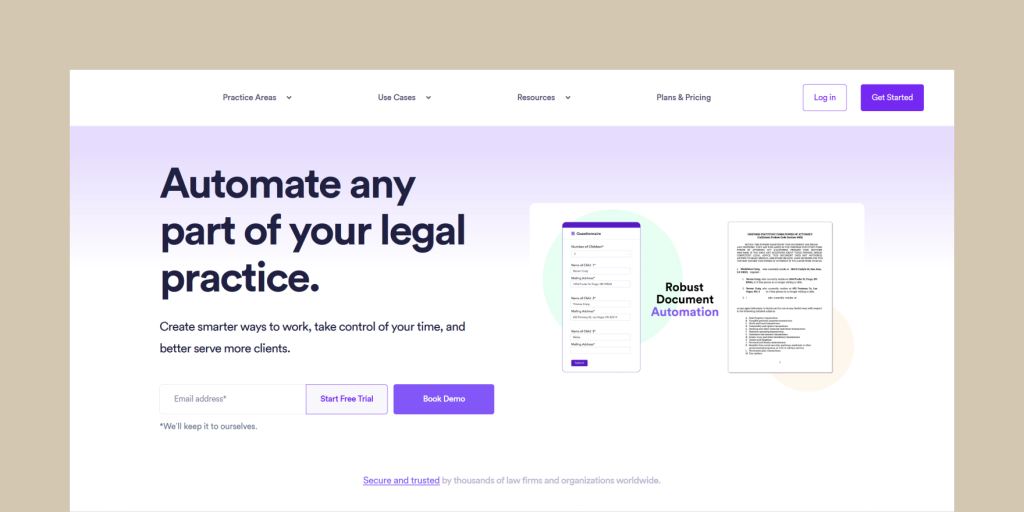
Our rating: 4.4/5
Pricing: Lite ($83/month); Standard ($165/month); Team ($290/month). Enterprise pricing available.
Who is this tool for? Law firms who want to automate production of their legal documents.
Best automation feature: Form-to-document workflow.
Gavel (formerly Documate) takes a traditional approach to legal document automation than you’ll see on a platform like PandaDoc.
With Gavel, you’ll be able to create and distribute customer-facing intake forms. Once you’ve collected data from your forms, you can insert the information into Word documents and fillable PDFs.
Based on this approach, the document automation tools provided by Gavel can be broken into three main parts:
Form generation
In this stage, you’ll generate forms and questionnaires that you can send to clients or customers.
The form building tools inside Gavel are robust, and you’ll be able to create custom forms that suit your specific needs.
While creating intake forms, you’ll also assign variables to the answer fields that you can when preparing your document later.
Document preparation
Next, you’ll need to create a form (or upload a PDF) inside Microsoft Word.
Gavel offers a Word integration that you can use to insert variables into your documents, so it’s easy to prepare your document for the automation process.
Document assembly
Once you’ve formatted your document, you’ll upload it to the Gavel workflow and send the form to recipients.
Users will fill out the form and, upon completion, Gavel will automatically insert the variables into your document based on your formatting and any predefined conditional logic.
As far as document generation goes, Gavel’s take is both practical and clever.
It’s perfect for law firms who need to fill out court documents and legal forms.
The customization available using the Microsoft Word add-in also allows for a layer of versatility while using familiar tools.
The setup process is easy, and document assembly happens practically in real time.
Once the intake form is completed, the document can be generated and sent wherever it needs to go.
Our favorite (somewhat hidden) feature is that you can actually use conditional logic to customize which document is generated based on the information that someone provides in the intake form.
Put another way, you could upload multiple variations of a document into a single workflow and Gavel will return the appropriate document for your purposes based on user inputs.
That’s a very unique feature, and one that savvy users can leverage to get even more mileage out of every workflow.
3. airSlate
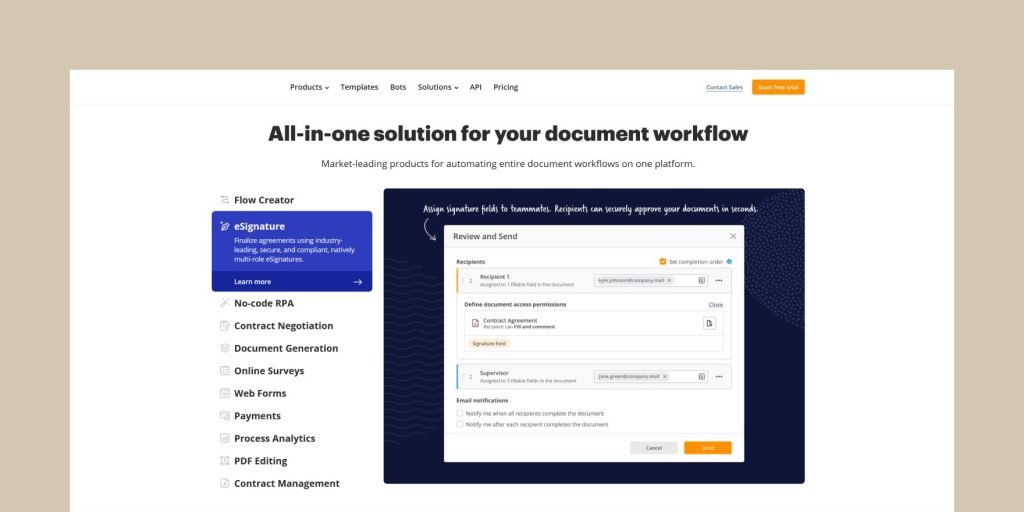
Our rating: 4/5
Pricing: Starter ($19/month); Growth ($79/month); Enterprise ($399/month); Automation Suite ($799/month)
Who is this tool for? Teams who want to save time by connecting data sources with fillable documents.
Best automation feature: Bots.
As a suite of tools designed to improve your document integration process, airSlate is packed with automation tools to expedite workflows, reduce human error, and generally make digital paperwork less of a hassle.
The platform is equipped with a variety of tools from e-signature capture and form generation to survey collection and payment capture. (Many of these same tools are also part of the PandaDoc product lineup.)
To be successful with airSlate, you’ll need two basic things: A collection of data that you want to use and a document where that data should end up.
Data sourcing
Your data source could be anything from an Excel spreadsheet to a Salesforce customer database.
Either way, you’ll need to create that dataset as part of a separate process.
Documents preparation
For documents, you’ll need to create a document and use airSlate tools in conjunction with a text editor to prepare it as a template.
This largely involves adding variables to your document so that it can be mapped to the information in your data set.
Once you have those two components in place, you’re ready to import your data from your source to your document.
The airSlate platform will provide you with field mapping tools so that you can specifically target where your inputs should go.
With those basic elements out of the way, creating multiple documents from a single dataset is as easy as clicking a few buttons and waiting while the system compiles your outputs.
This automated process is called a “bot,” and it’s one of the coolest features inside the platform.
The company defines bots as workflows that automate manual tasks.
You can use them to import or export data, set reminders, create new records, and much more.
In fact, the level of bot customization and versatility is staggering.
The only real problem is that your plan caps your bot usage on an annual basis — and the numbers can feel quite small if you’re doing a fair amount of automation.
But, even with those downsides, airSlate is a great place for document automation.
That’s especially true if you have a Microsoft Office subscription and don’t mind taking those extra steps to prep and format your documents.
4. Conga Composer

Our rating: 4.1/5
Pricing: Pricing not listed.
Who is this tool for? Companies who want to leverage Salesforce data to create a streamlined document workflow.
Best automation feature: One-click document generation.
If you’re using Salesforce to manage all of your customer data, Conga Composer is worth a look.
Like PandaDoc, Conga offers a direct Salesforce integration, allowing you to pull data from your CRM into documents that you want to generate.
Essentially, Conga Composer gives you a workspace where you can build document templates that are accessible in Salesforce.
You’ll set up variables and map them to custom objects within the CRM.
When reps generate the document, all variables are automatically filled and documents are instantly created.
So, how does Conga benefit your team?
Generates Word, Excel, PDF, PPT, and emails
You can create templates for most standardized formats using Conga.
That’s a lot of flexibility, and it gives your team a variety of ways to create relatable customer content.
One click document creation — from Salesforce.
If your team prefers to work exclusively in Salesforce, they’ll be able to produce documents with a single click from inside the CRM interface.
Multi-product integration
The Conga family of products doesn’t stop with Conga Composer.
You can also sign up for Conga Sign, Conga Contracts, and other products in the Conga suite — but we feel like it’s worth noting that PandaDoc offers one platform and one complete product with coverage that would span multiple Conga products.
Email integration
One of the things we found interesting with Conga is the ability to integrate directly with emails.
Using Composer, you can create a template for documents and emails so that your entire outreach process is handled in just a few clicks.
As a document automation platform, Conga is a powerhouse for the right team.
The app has a slight learning curve (what app doesn’t?), but it comes with pre-built templates so that you can start optimizing your document processes at the drop of a hat.
When Composer is up and running and your sales team is onboard, you’ll be able to say goodbye to tedious document management processes.
Click, generate, save, and send. It’s that simple.
5. HotDocs
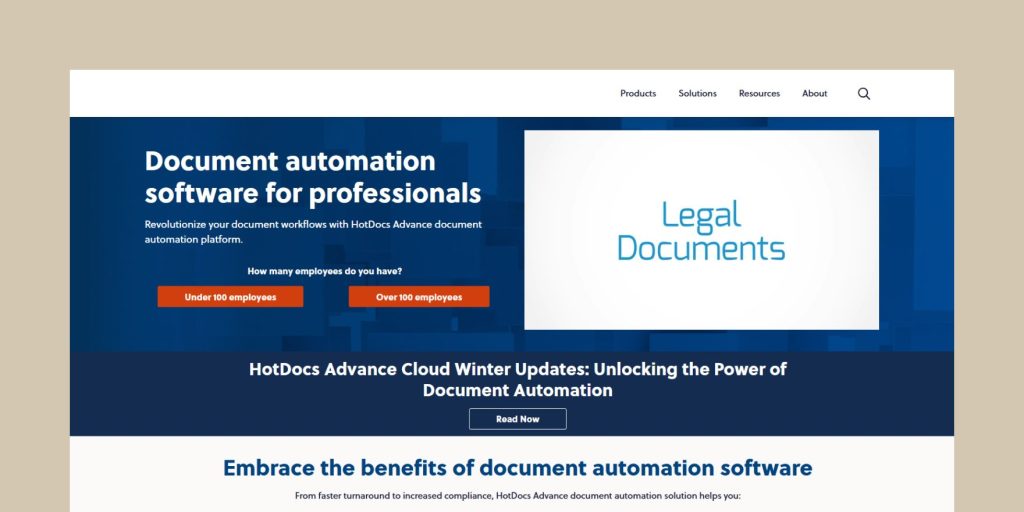
Our rating: 3.9/5
Pricing: Pricing not listed.
Who is this tool for? Businesses of any size who want to eliminate manual document management processes.
Best automation feature: Conditional clause insertion for docs.
If you’re looking for one of the original document automation solutions, HotDocs is it.
The company has been around since 1993 and has largely specialized in document automation and assembly from the very beginning.
Of course, document automation is a competitive space, and HotDocs has worked hard to introduce new features and processes that allow it to remain relevant to modern users.
Similar to workflows like Gavel (featured above), HotDocs distills its document automation process to a few brief steps:
Template creation
Like every other automation solution, you’ll first need to create templates using HotDocs.
This is done by integrating the HotDocs editor into your word processors and using the tool to create templates from your existing documentation.
When you’re done, you can upload that template to the cloud for later use.
Interviews
HotDocs distills its data collection process down to an intake form, called an interview.
You’ll create the form around the variables used when building your template.
Users will fill out the interview with the appropriate information, which is mapped to the variable properties in your HotDocs template.
Assembly and export
Once the interview is complete, HotDocs will plug the provided data into the assigned template and return a finalized document to you.
At first glance, the HotDocs workflow might seem simplistic, but everyone from small businesses to Fortune 500 companies have leveraged this process to great effect.
The latest version of HotDocs (HotDocs Advanced) also comes with features like electronic signature integration and machine learning capabilities for automatic contract generation, so there is plenty of technology under the hood to help your document creation process thrive.
If you’re looking for a document assembly software that can fill a ton of use cases, give HotDocs a closer look.
6. Templafy

Our rating: 4.4/5
Pricing: Pricing not listed.
Who is this tool for? Brands who want to ensure document brand compliance through automation.
Best automation feature: Backend UI for document and asset management.
Any brand manager will tell you that compliance is always an issue.
Even if you’ve selected brand-approved imagery and templates, getting someone to willingly follow those guidelines can be a major challenge.
Solutions like content libraries and pre-approved templates can help — both of which are features in the PandaDoc lineup — but if you’re looking for a compliance-focused automation tool, Templafy deserves a look.
With Templafy, you’ll get an even mix of software tools designed to help manage the look and feel of your brand.
Unified document creation
With Templafy, brand managers can take control of nearly all documents generated by an organization — all the way down to email signatures.
This allows managers to set guidelines with pre-approved image libraries and document and layouts.
Compliance and management tools
Using these same tools, managers can automate documents, create templates, and govern document information so that everything is appropriately classified and organized for standard users.
Works where you work
Users won’t have to work inside Templafy to take advantage of the standardization created by the platform.
Templafy integrates with Google Workspace, Microsoft Office and other platforms so that it can guide document creation from anywhere.
Onboard analytics
Want to know how your documents are doing?
As with PandaDoc analytics tools, Templafy provides onboard performance metrics so that you can see how documents are used and which templates are performing well.
If you’re familiar with PandaDoc, you might know that we have an onboard content library to help administrators manage and maintain document templates.
Templafy takes that same concept to an entirely new level.
The platform is, in many ways, less of a document management software and more of a content management library that happens to extend to document automation.
For brands looking for ironclad governance and compliance, Templafy does an outstanding job filling this niche.
7. Formstack
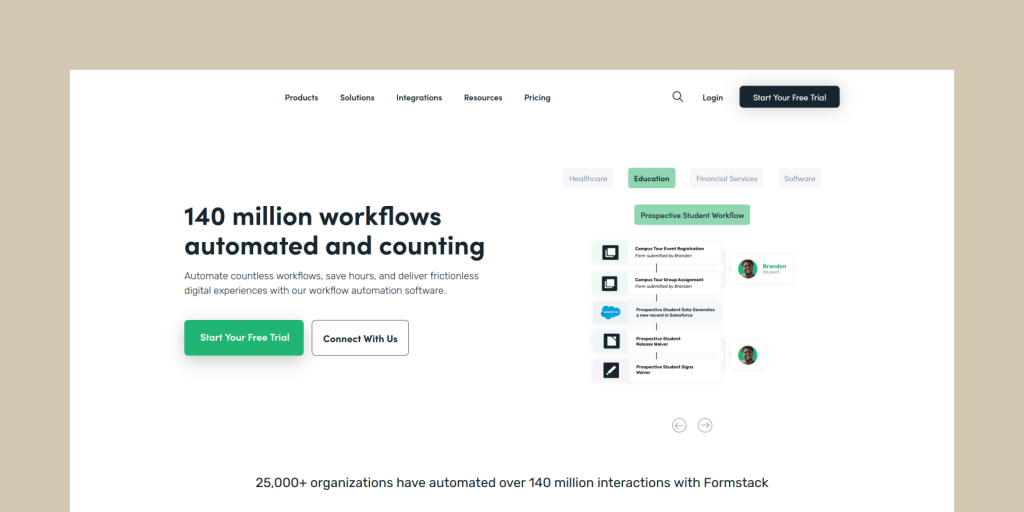
Our rating: 4.2/5
Pricing: Suite ($66/month); Standalone app ($92/month).
Who is this tool for? Teams who need turnkey document generation and delivery.
Best automation feature: The plug-and-play input and delivery systems.
Of all the document automation platforms on our list, Formstack Documents (formerly WebMerge) comes across as one of the most versatile because of how it positions itself.
Formstack Documents wants to sit between your data source and your output source.
Like PandaDoc, Formstack Documents is equipped with an onboard document editor that allows you to create any document you might need.
The key difference is that Formstack wants to automate by connecting to both a data source and your output location so that it can pull data from the source, create the document, and send it wherever it needs to go.
It’s a unique solution in the field with several key features.
Integrations galore
Formstack thrives on integrations.
With Formstack Documents, you’ll need to connect to a data source in order for the automation to work.
With that in mind, Formstack has an integration for many CRMs (including email marketing platforms) so that you can quickly access the data you need.
Multiple outputs
From PDFs to Powerpoint, Word, and Excel, Formstack Documents allows for a variety of document outputs.
The ability of the platform to sit between your input source and your desired output format provides added flexibility for the setup.
Part of the Formstack family
Formstack Documents isn’t alone. Formstack Forms and Formstack Sign are also part of the Formstack product line.
You can branch out to other tools if you need them or sign up for the bundle and get all three products at a lower cost.
At PandaDoc, we’re never huge fans of multiproduct solutions.
Our e-signing and form creation tools are bundled into the PandaDoc platform, so everything is included in your subscription.
It’s clear that Formstack largely agrees with an all-in-one setup, too, considering the steep discounts you’ll receive when buying the platform as a package deal.
8. Crove
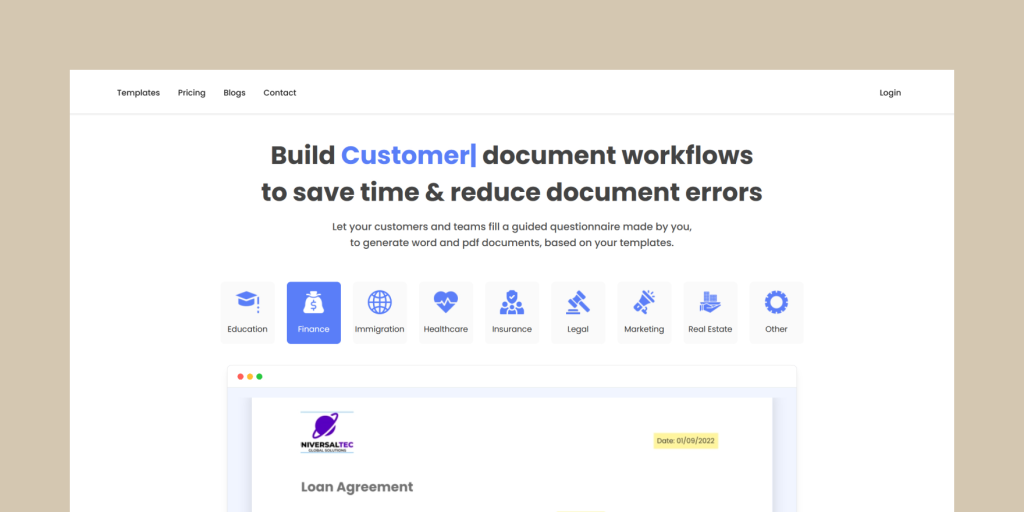
Our rating: 4.3/5
Pricing: Personal Plan ($99/month); Business Plan ($199/month); Enterprise pricing available.
Who is this tool for? Organizations looking for a no-code, visual solution to document automation.
Best automation feature: Real-time variable editor.
At first glance, Crove might look like most other document automation systems out there. (To be fair, how original can you be when almost everything comes down to variable insertion?)
As with HotDocs and Gavel, Crove uses the questionnaire-to-document method for data capture and insertion.
Teams will need to design both the template and the form, then map the variables appropriately for the automation process to take place.
However, even following that standard process, Crove has a few rare features that deserve a closer look.
Live variable insertion
One of the key differences between Crove and other competitors is the ability to see variable replacements while you work.
PandaDoc provides similar visual confirmation, but most platforms work in the background and only show the finalized document once the automation has taken place.
Visual conditional builder
While Crove offers conditional logic for various components of document creation, the tools to do this aren’t complex.
For documents, you can use conditional logic to insert specific snippets to the final output based on what users select during the intake process.
Form builder
As with other tools, Crove relies on user input from forms.
However, the app comes with an onboard form creator (similar to Gavel) that you can use to build everything right inside the app.
Integrations (reminders, payments, etc.)
Even though it’s a smaller app, Crove integrates well with a variety of tools.
This enables Crove to facilitate payments, reminders, and more by connecting to apps that provide those services.
In many ways, the Crove experience is similar to what we’ve tried to implement within our own workflow.
You’ll find an onboard document editor, form building tools, variable creation, and more inside both Crove and the PandaDoc editor.
However, you’ll find PandaDoc solutions available at a much lower cost.
That’s especially true considering that Crove limits the number of templates you can create on the personal plan ($99/month) to 10.
We like Crove, and we’re curious to see where it’s going.
The visual editor is top notch. Be sure to check it out but — if you like it — we’d encourage you to take another look at PandaDoc, too.
9. Document Studio for Google Sheets
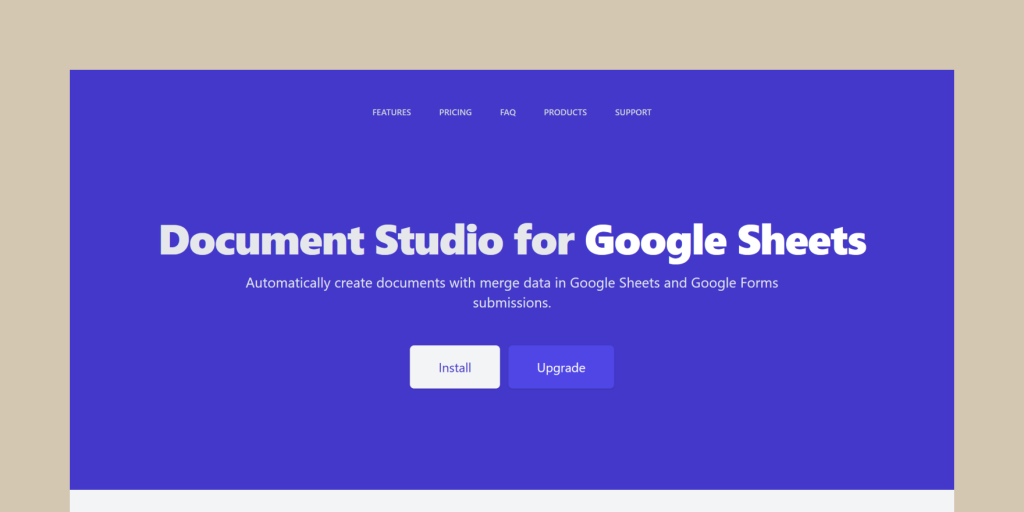
Our rating: 4.1/5
Pricing: Standard ($80 user/year); Enterprise ($100 user/year).
Who is this tool for? Google Workspace power users who want to keep their automation processes inside Workspace.
Best automation feature: Mass document creation.
Do you love working in Google Sheets?
If you’re well-versed in Google’s productivity suite, Document Studio might be the best item on our list.
This app is different from the other platforms on our list in that it’s a Google Workspace add-on.
You’ll need to download it from the Google Workspace Marketplace, and it will automatically plug into your Workspace setup.
From there, you’ll be able to activate it by enabling the add-on from the Extensions menu item while working.
So, why use it? Let’s take a closer look.
Powered by Google
This Workspace extension operates entirely within the Google Suite without exporting data to a separate cloud service.
While you will use the add-on interface to interact with the software tools, you’ll always work inside the Google platform to create and execute your automations.
Automated outputs for documents and emails
Document Studio’s tools allow you to create any kind of document while supporting a variety of output formats.
You can also connect with your email account and use it to schedule and send emails.
Integrations beyond Google
If you prefer, you can integrate Document Studio with apps like Slack, Trello, Stripe, and similar productivity tools, extending its reach beyond Google Workspace.
This unique solution caught our eye specifically because of its adherence to Google Workspace.
Millions of users love Google and want to do more with the productivity tools provided in Workspace.
Document Studio largely relies on a working knowledge of Google Sheets in order to function.
Data flows into Sheets and maps to document variables that you’ll create by editing documents inside Google Docs.
The process is similar to what you’ll experience in other automation platforms while remaining contained to a familiar set of tools.
While this solution won’t be a perfect fit for everyone — especially if you don’t want to spend your days working with spreadsheets — but we know that Workspace power users might want to try it for themselves.
10. DocuSign Gen for Salesforce

Our rating: 4.6/5
Pricing: Pricing not listed.
Who is this tool for? Sales teams who want to automate document creation using Salesforce data.
Best automation feature: Conditional content variables.
You can’t really talk about document automation without mentioning DocuSign.
Although the company is most widely known for its e-signature solutions, DocuSign has expanded heavily into automation with platforms like the DocuSign Agreement Cloud and DocuSign CLM.
Gen for Salesforce is DocuSign’s way to help users merge Salesforce data (including product and pricing details) into document formats that can be signed and exported.
Here’s why Gen is worth a look for Salesforce teams:
All tools in one place
You can use Gen from directly inside Salesforce, so your reps won’t have to switch back and forth between apps to generate the documents they need.
Once the templates are set, reps just need to click a few buttons and customer details are added to documents programmatically.
Custom conditional variables
One of our favorite features, conditional variables allow you to customize outputs based on information already accrued in Salesforce.
Does your liability change when working with customers from around the world?
With Gen, you could set up conditional content insertion to change the legal language based on customer location.
And that’s just one example of how this logic-based system can work.
Integration with DocuSign e-signing
While PandaDoc is our preferred signing method, you can’t argue with the ease of use that comes with the DocuSign signing process.
Fast, simple, and straightforward, document preparation and signing are a breeze.
Naturally, Gen integrates with DocuSign e-signing tools so that you can capture valid signatures as part of the process.
As you might expect, Gen won’t be a great fit if you’re not using Salesforce to hold your customer data. The two are deeply intertwined.
Of course, we should take a moment here to mention that Gen isn’t the only way to integrate your Salesforce information into your documents.
PandaDoc does it, too, using our native Salesforce integration. Just like Gen, you can use PandaDoc from directly inside Salesforce.
With a few clicks, you can populate data and send documents while still using the sending, tracking, and signing tools provided by PandaDoc to close your deals.
The best part? You can also use PandaDoc with other leading CRMs or as an entirely standalone product. So, if your company wants to break away from Salesforce, PandaDoc can go with you.
11. Jotform PDF Editor
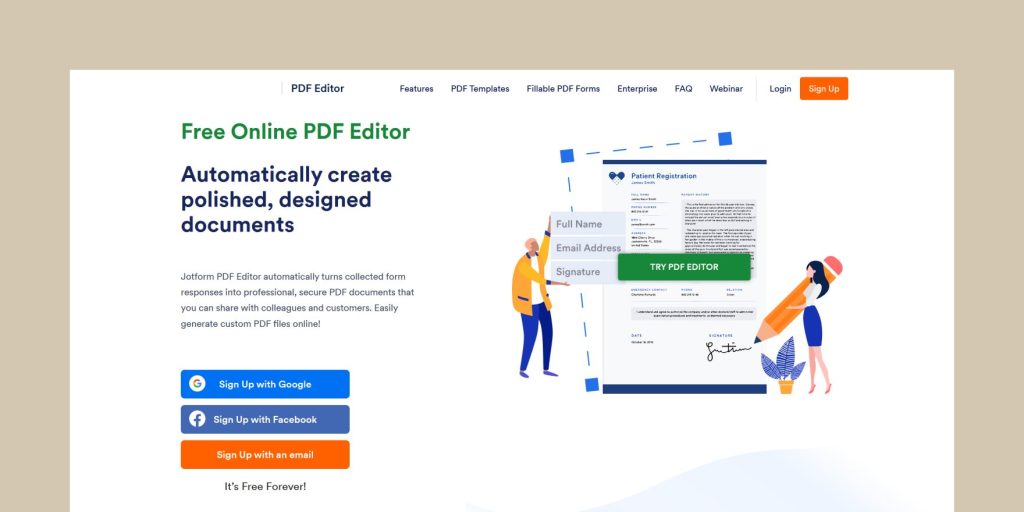
Our rating: 4.6/5
Pricing: Free.
Who is this tool for? Teams and individuals who need a simple way of adding form data to a PDF document.
Best automation feature: Quick and easy output customization.
Compared to most of the other automation software tools on our list, the PDF editor provided by Jotform might feel a little thin when it comes to features.
At first glance, Jotform lacks many of the advanced automation features you’ll see in other apps.
However, the Jotform editor is completely free and can get the job done with a little creative thinking.
Here’s a closer look at where this app shines:
Simplified form creation and PDF insertion
With Jotform, the emphasis is on form creation rather than variable insertion or document automation.
The PDF editor is no different.
While this editor comes with an onboard PDF builder, you won’t be able to use these tools for complex variable replacements.
Hundreds of free templates
If you use Jotform, chances are excellent that you won’t have to create a form from scratch.
That’s certainly an option, but it’s often easiest to choose one of the hundreds of forms in the library and customize it.
Onboard signing and payment capture
Although this is limited by the plan you’re using, it’s possible to capture e-signatures and payments on every Jotform plan (including the free one).
Combined with the PDF editor, it’s possible to issue customized receipts and confirmations with all relevant data attached.
We know that this PDF editor won’t be a good fit for businesses looking to scale their operations, but it’s a great option for budding entrepreneurs and individuals with a side hustle.
Customers will fill out the form, and the PDF attached to that form will generate the appropriate document upon submission.
Like we mentioned earlier: This tool won’t be great for complex variable substitution.
But, with a little creative thinking, the forms and features Jotform provides can handle a myriad of document needs.
Which document automation software is best for your business?
Even with all the information we’ve provided above, finding the perfect fit for your business is still a process of trial and error.
There simply isn’t a one-size-fits-all solution that is a perfect match for every single brand.
However, if we had to pick, here are our choices for which items you might want to consider.
Best for small businesses: Document Studio for Google Sheets
Both from the perspective of cost and capability, it’s hard to ignore Document Studio.
It’s an add-on with a relatively low annual cost, especially compared to many of the other platforms on our list.
Google Workspace gives you everything you need to operate a small business.
Document Studio synchronizes those tools so that document automation becomes viable even for freelancers and small enterprises.
While it doesn’t have a slick user interface or a ton of advanced tools for enterprise-level operations, it’s more than enough for small teams to prepare and send business documents without ever leaving the Google platform.
Best for brand-conscious managers: Templafy
If brand management is your priority, Templafy does a great job here.
We’re not saying that it’s impossible to manage brand content through other platforms.
PandaDoc even offers its own suite of brand management tools, but Templafy seems built for purpose when it comes to brand compliance and document governance.
Brand managers who want to present a united front and organizations who need to demonstrate consistency at the highest level will benefit from everything that Templafy can offer.
Best for moderate, large, and enterprise businesses: PandaDoc
For businesses that need the perfect synthesis of document creation, automation, and collaboration, PandaDoc is the best overall performer.
Our suite of document tools allow for nuanced, from-scratch creation along with automation and workflow integration with the rest of your tech stack.
On top of all that, collaboration tools like approval workflows, in-line commenting, and virtual deal rooms bring a set of tools to PandaDoc users that you just won’t see combined in most other platforms.
How we sourced our data
To accurately assess each of the tools covered in this article, we went over 50 different websites to calculate the aggregated value for each entry on the list.
The types of websites covered in the analysis include software review websites, user-review websites, along with websites of the mentioned SaaS tools.
To tackle this issue, the data sources were grouped into five cohorts based on monthly visitors (which we took from Semrush):
- >1.000.000 visitors;
- 500.000 – 1.000.000 visitors;
- 250.000 – 500.000 visitors;
- 50.000 – 250.000 visitors;
- <50.000 visitors
The websites from the first group were assigned a higher score and had complete priority in our content analysis.
The further down this list, the less relevant the information, and the more vetting was required to make sure the data was correct and objective.
Some examples of the most relevant sources we used:
- Unbiased reviews of eSignature category from Investopedia.
- Comparison pages of Docusign from Capterra.
- Reviews and average rating analysis from G2.
- Best eSignature solutions in 2021 per TechRadar.
- Best-rated eSignature platforms on TrustRadius.
Finally, the websites of the respected tools were used only for factual data such as pricing, free trials, the exact features, etc.
To keep the article objective, their own perceptions of their tools were not taken into consideration in any way.
Get started with PandaDoc today!
There are a lot of great document automation tools out there, and we hope you found this list helpful.
We know that exploring 10+ automation tools can still be a challenge (even though we’ve done our best to narrow things down a bit for you).
Save the extra step by giving PandaDoc a try before anything else.
That way, you’ll always have a good basis for comparison and a robust set of features at your disposal.
Ready to get started?
Sign up for a free 14-day trial with PandaDoc or schedule a demo with a product expert to see the PandaDoc difference firsthand.
Disclaimer
PandaDoc is not a law firm, or a substitute for an attorney or law firm. This page is not intended to and does not provide legal advice. Should you have legal questions on the validity of e-signatures or digital signatures and the enforceability thereof, please consult with an attorney or law firm. Use of PandaDocs services are governed by our Terms of Use and Privacy Policy.
